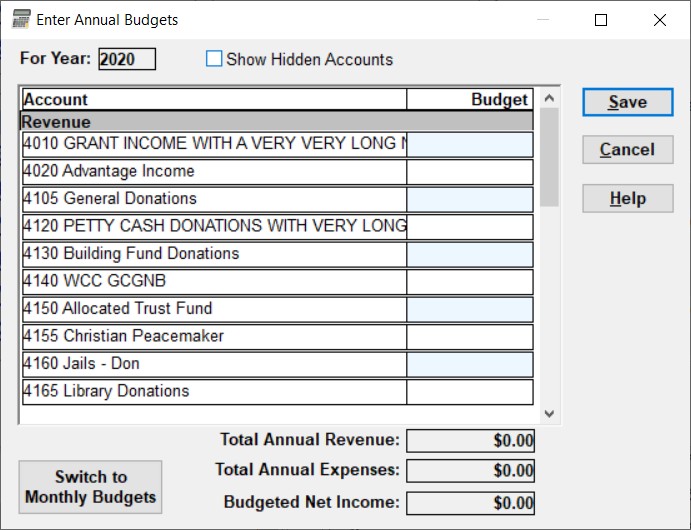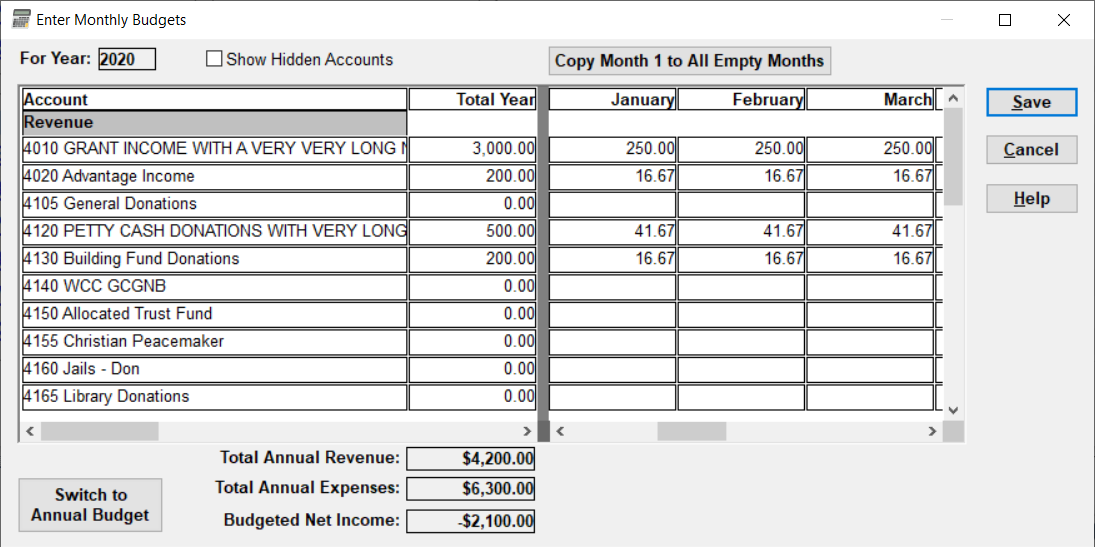In ACCOUNTS, you can have a budget for income and expenses for each year. Budget figures can be for a whole year, which the program calls an Annual Budget, or they can be split out by months, which the program calls a Monthly Budget.
If your fiscal year is set to be different from the calendar year in the Maintenance ⇒ Organization Info window, the budget will be for the fiscal year. Please note that a year such as "Fiscal 2019" means the year whose last day is sometime in the calendar year 2019.
To create or edit a budget for a given year or fiscal year, use the Maintenance ⇒ Budgets menu option. That first brings up the following window:

It comes up defaulted to the current year (or fiscal year). After choosing your desired year and clicking OK, a window such as the following one comes up, if you have never previously entered any budget figures for that year:

Obviously, this is just a sample with some test accounts. You can size the window to show more of your accounts by clicking and dragging on the top or bottom edge.
Every income and expense account in your chart of accounts that you can post transactions to is always displayed in this window. (That means, the ones with no sub-accounts.)
Whether or not that includes accounts that you have marked as "Hidden" depends on whether or not you check the Show Hidden Accounts checkbox. If you are showing them, hidden accounts show in italics.
Enter an amount in the Budget column for each account that you want to budget for, and leave the Budget column empty for the accounts that you don't want to budget for.
If an annual budget has already been entered for the selected year, the previously entered values will be displayed in the Budget column. The totals of income and expense budget amounts and your budget surplus/deficit for the entire budget year are displayed at the bottom of the window, and are updated as soon as you enter each value and move to another row. (The wording used for those values at the bottom of the window will depend on your selections in the Maintenance ⇒ Entity and Report Names window.)
Once you have entered all of your desired annual budget amounts in the Budget column, click Save to save them. You can alternatively click Cancel to abandon your changes.
If you have entered a budget for one year, and go to enter a budget for the next year for the first time, you will be given an option to copy over the previous year's budget as a starting point for the new year's budget.
Monthly Versus Annual Budgets
If you have some income or expense accounts where the actual amounts are expected to vary in known ways during the year, you may prefer to specify a monthly budget with some months' values different from other months', for some accounts. (Likely most accounts will be assumed to have even amounts in each month.)
If you are setting up a budget for the first time, and would prefer to be able to make some month by month changes, the easiest way is probably to first set up your Annual Budget totals in the window shown above. Then you can click the Switch to Monthly Budgets button at the bottom of that window, which first asks for confirmation, then if you answer Yes, recalculates the same amounts as Monthly Budget amounts by dividing by 12, and displays them in a window such as the following:

In this example, some Annual Budget amounts had first already been set up. You can size the window to show more of the monthly columns by clicking and dragging on the left or right edges. You can also scroll the months with the horizontal scroll bar in the right size of the window (after the big vertical grey bar). There is one column for each month. The Account name and overall Total Year column at the left cannot be scrolled. The Total Year values constantly update as you make changes to the monthly values and move out of a field. The Total figures at the bottom of the window are totals of that Total Year column.
The displayed month names in the column headings will depend on your fiscal start month as set up in the Organization Info window - the first column will always be the first month in your fiscal year. However, if your fiscal start day is not the first of the month, the column headings will just read "Month 1" through "Month 12".
Since not all numbers can be evenly divided by 12, when you convert from an Annual Budget to Monthly Budget, to avoid fractional cents, and keep the same totals, a small adjustment of a few cents may have to be made. That adjustment will be added or subtracted to the Month 12 value, so it may be slightly different from the other months.
Now you can click into this window and make any changes you wish. If you prefer not to have any cents in your monthly budget amounts, you can of course edit each amount with cents as desired, keeping in mind that any change will change the annual total for that account, which is displayed at the far right.
You can also add consistent monthly budgets for new accounts or any accounts that do not yet have budgets quickly, by first filling in only the Month 1 figures. Then click the Copy Month 1 to All Empty Months button at the top of the window. That will fill in any empty spaces on rows for accounts that have a value in the Month 1 column, with that same value. You can make any desired further adjustments after that.
One final option is if you have set up monthly budgets and decide you really don't need to have different budget amounts in different months, you can use the Switch to Annual Budget button at the bottom of the window to switch back to annual. That just replaces the monthly budgets with their total, as annual budgets, and goes back to the other version of this window.
Using Budgets
You can review your budgets with Reports ⇒ Listing ⇒ Annual or Monthly Budget, which just lists your specified budget amounts, and totals.
The most common use of budgets is via Reports ⇒ Summary ⇒ Budget Comparison, which prompts for a range of dates within one budget year, then shows the income/revenue and expenses for the selected range of dates (the "actuals"), the portion of the budget for that range of dates, and the difference between the actuals and the budget.
There is also Reports ⇒ Fund ⇒ Budget Comparison, which does the same thing, but split out by fund.
And finally you can also include budget columns in Custom Reports.
The budget figures in any of these reports will always be based on your specified range of dates for the report, calculated as a fraction of your annual budget if that is what you are using, or as multiple fractions of the appropriate monthly budgets if that is what you are using. All budget reports must be within one year (or fiscal year if that is different from the calendar year).
This topic was last edited on Sep 20, 2021